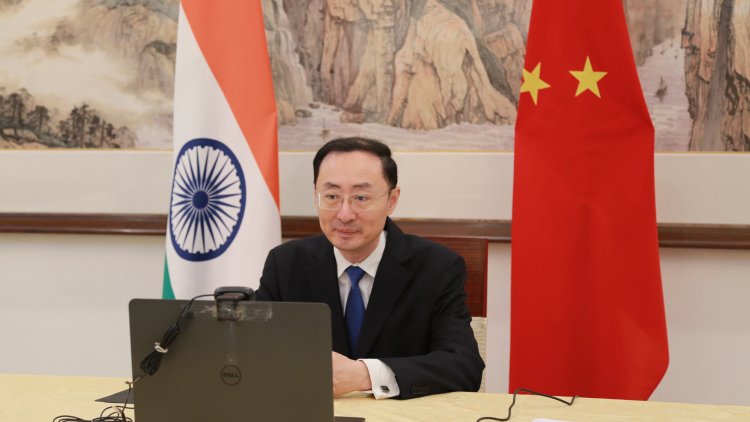India - China: Settle Border through Dialogue - Chinese Ambassador
STORIES, ANALYSES, EXPERT VIEWS

China has once again suggested a final settlement of the boundary dispute through dialogue, saying the time has come to ensure that there were no more military stand-offs between the two countries along the Line of Actual Control (LAC).
Referring to the deadly clash between Indian and Chinese troops at the Galwan Valley on 15 June last year, Chinese Ambassador to India Sun Weidong admitted that every time such an incident occurred, the bilateral relationship was pushed back by years. These remarks were made by the envoy in a virtual dialogue Sun had with Sudheendra Kulkarni, media commentator and a close aide to former Prime Minister Atal Bihari Vajpayee, on Friday. The Chinese Embassy today released the text of the dialogue.
Sun said the recent disengagement between Indian and Chinese troops at the Pangong Tso Lake was conducive to building trust and further easing the situation on the ground. “Against this backdrop, we should implement the consensus reached by the two leaders (of the two countries) and strictly abide by the existing agreements, step up dialogue and communication, and improve the border management and control mechanisms to further ease, stabilise and control the border situation, avoid relapse and jointly safeguard peace and tranquility in the border areas,’’ he added.
The lesson of last year’s border dispute (Galwan clash) was profound and such incident should not be repeated.
Recalibrating China specific strategy
The Chinese Ambassador’s assertions appear right when relations are seen in retrospect. For almost 50 years, writes Ganesh Natarajan & Ajit Ranade (Strategic Affairs Experts) the bilateral relationship “was able to keep the thorny issues of border settlement and of deeper economic engagement separate. Bilateral trade grew at 20 per cent per annum during the first 15 years of this century. India went from being number 19 to six in Beijing’s list of export destinations.
“Both were enthusiastic supporters of the BRICS grouping which has led to the formation of a development bank and an annual summit, of which the thirteenth one will be held in Delhi next month. Over the years, the frequent meetings between President Xi Jinping and Prime Minister Narendra Modi have created an expectation that this could truly be the hallmark of an Asian century when the two countries could work as partners and friends.”
But with the border clash, “China has unilaterally dismantled the status quo, and has signalled a more hostile stance towards India. This has raised important questions for policymakers in India.” India reacted by mobilising troops and imposing economic sanctions like the banning of Chinese apps, restrictions on capital flows and emotional boycott of Chinese goods etc.
Medium-to-long term strategy: But that is not a medium-to-long term strategy. Ganesh Natarajan & Ajit Ranade believe that the long-term strategy “calls for lesser economic dependency, stronger diplomatic and geopolitical coalitions with likeminded democracies, and a stance of calm confrontation of Chinese aggression.”
They argue that “in the short run, India will have to build balancing coalitions with likeminded countries, as, indeed, we are doing through Quad with the United States, Japan and Australia. We envisage three groups of countries that we can engage with in such coalitions: major democracies of the world, countries bordering China, and India’s own neighbours, all of whom have a lot to gain in preventing the rise of China as a malevolent and autocratic superpower. We need to go beyond treaties and agreements and engage deeply with these 20 countries, encouraging frequent exchanges at multiple levels: diplomats, economists, scientists, academics, innovators and entrepreneurs.”
The two authors suggest that “a selective retreat from economic engagement with China and increased emphasis on the global market would be an ideal approach to take in the next two decades, which can result in starting with ‘less China’ and eventually approaching a near-‘China-less’ state of our nation.”
Industry-specific strategies: The authors did an assessment of the global opportunities and the relative status of India and China to identify and advocate industry-specific strategies in the following three broad categories of the industry sectors:
“1. Huge asymmetry areas where India must progressively reduce dependence. Rare Earths are a classic example.
- Opportunities to focus on ‘atmanirbharta’ (self reliance) and meet all domestic demand. Telecom is an immediate imperative.
- Global industry-building opportunities. These exist in chemicals, pharmaceuticals…..automotive” etc
In the medium-to-long term, argue the authors “China has its own vulnerabilities. Its demography is ageing and workforce declining. Its growth will surely slow down……It is possible that China may grow at four per cent while India can grow at close to eight per cent for the foreseeable future. This changes the skewed ratio of economic size from 5:1 to just about 2:1. To achieve this high and sustained growth, India has a domestic economic reforms agenda to pursue.”
















